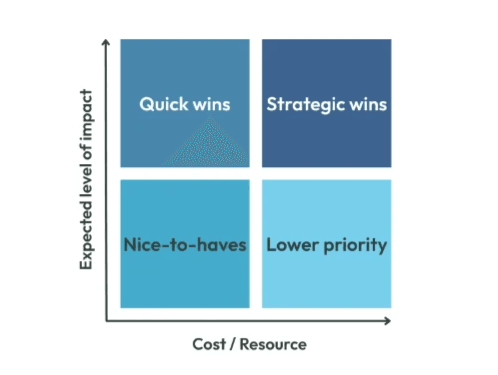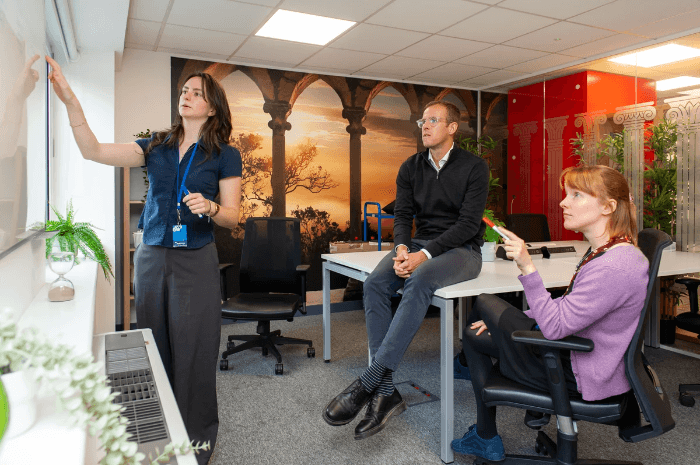Sustainability isn’t just a buzzword, it’s becoming a business imperative.
To explore what that really means in practice, we sat down with Ben, our Sustainability Strategy service lead at Pointer. Drawing on his background in public service strategy, Ben brings proven practices from national institutions and adapts them to suit SMEs, helping them pursue sustainable growth, a challenge that’s becoming increasingly relevant amid today’s market fluctuations.
Q1) How has sustainability featured in your career?
Sustainability is an area of my skillset that enables me to help businesses become more successful. I
have taken a lot of the learnings and experience from my previous roles in procurement, commercial/budget management and strategy, to help inform my understanding of the variety and complexity of challenges businesses face. During my time at Pointer, I have used this insight to develop our service offering and help businesses to become more sustainable.
Q2) What does sustainability mean to you? And how does that link to the strategic work that you do?
There is a huge focus on the ‘E’ of ESG (Environmental, Social, Governance). When we think about sustainable business, we often default to emissions and carbon footprints. These are hugely important aspects of sustainability, but they represent only part of the story for businesses seeking to position themselves in a competitive market.
According to the Cambridge Dictionary, sustainability is defined as “the quality of being able to continue over a period of time.” In this sense, sustainability is more than just your business’s impact on the environment. It also encompasses how your business enables itself to continue operations over a period of time. From a strategic perspective, this means looking at how your business operates and identifying inefficiencies.
Using ESG as a framework to assess where your business practices are thriving and where they need improvement, you can then create a plan to execute projects that deliver clear benefits across all three areas.
In summary, sustainability should encompass E, S, and G to determine your business’s strengths and weaknesses, and to subsequently guide a plan for improvement. The result is a business with a holistic approach to sustainability, implementing a range of actions that increase its chances of long-term success.
Q3) So how would you go about engaging with the current business strategy and the team behind it, to create a more holistic approach?
Ultimately, every business should have a purpose (why) and a vision (where you want to get to), otherwise, why are you operating? No action you take as a business should contradict that purpose or vision. Ideally, everything you do should work towards making your purpose and vision a reality, whether that means developing a new product, switching to a new organisational design, or trying a new supplier.
At Pointer, we typically start by helping a business review their existing purpose and vision, or by helping to create them, and then determine whether they accurately represent what the business aspires to be. From there, we build on this foundation by identifying the areas that the business should focus on across the sustainability landscape, using a series of materiality focused exercises. The aim is to provide clarity and confidence around where the business should direct its efforts.
When you think about making your business more sustainable, this approach ensures you are considering how potential actions complement your purpose and vision. Ideally, everything is working towards the same goal: a prosperous company now and in the future.
Q4) If there is internal resistance to embedding a long-term sustainability strategy, how do you navigate it?
Admittedly this is tricky, but it comes down to how you position this activity across your business with your key stakeholders (internal and external). By focusing on the right activities now, your business can unlock significant benefits in the future. A nice way to visualise this is to create a impact/cost matrix (shown in Figure 1 below).

Figure 1) Impact/ Cost Matrix
This enables everyone involved to differentiate between strategic wins, quick wins, lower priority actions and nice-to-have actions. These categories will help you to craft your implementation plan, and effectively land the prioritisation of action, risk and resource constraints over time. If you get the balance of cost and impact, the plan can then feel less daunting and ease resistance across your stakeholders.
Q5) What are the key trends or external pressures that you see at play in sustainable business strategy and practice at the moment?
The macroeconomic climate is definitely something that businesses can’t ignore right now. Rising costs, a slower market, and a lot of uncertainty mean many companies end up “firefighting” instead of planning strategically. When that happens, things like a sustainability strategy, and the projects that flow from it, can easily get pushed aside as a nice-to-have rather than a priority.
At Pointer, we try to reframe that thinking. Getting a sustainability strategy in place isn’t just an add-on, it’s actually the first step we encourage, because a holistic approach to sustainability improves a business’s chances of sustaining and succeeding in the future.
Q6) If you could embed one idea into every business conversation about sustainability, what would it be?
I’d encourage every business to ask themselves one simple question: Do we truly understand how well positioned we are to be sustainable, and therefore successful, in the future?
If the answer is no, or even a hesitant yes, then the next step should be figuring out how to change that. It starts with developing a sustainability strategy that complements the wider business strategy, and then mapping out the actions and projects needed to bring it to life.

If you're ready to build a sustainability strategy that drives your company’s future growth, get in touch with us at info@pointerconsultancygroup.co.uk to start the journey.

